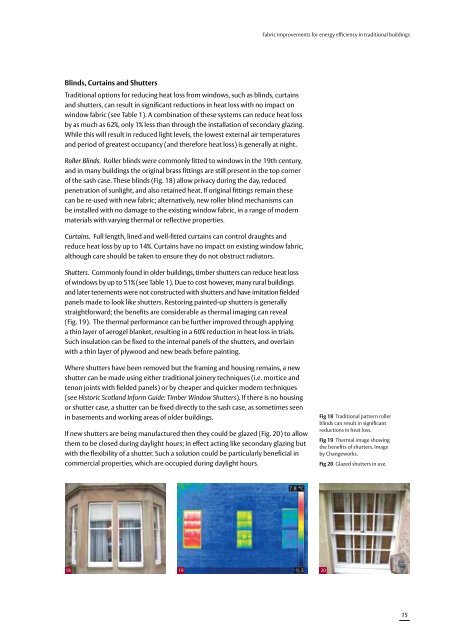Fabric Improvements for Energy Efficiency in ... - Historic Scotland
Fabric Improvements for Energy Efficiency in ... - Historic Scotland
Fabric Improvements for Energy Efficiency in ... - Historic Scotland
You also want an ePaper? Increase the reach of your titles
YUMPU automatically turns print PDFs into web optimized ePapers that Google loves.
<strong>Fabric</strong> improvements <strong>for</strong> energy efficiency <strong>in</strong> traditional build<strong>in</strong>gs<br />
Bl<strong>in</strong>ds, Curta<strong>in</strong>s and Shutters<br />
Traditional options <strong>for</strong> reduc<strong>in</strong>g heat loss from w<strong>in</strong>dows, such as bl<strong>in</strong>ds, curta<strong>in</strong>s<br />
and shutters, can result <strong>in</strong> significant reductions <strong>in</strong> heat loss with no impact on<br />
w<strong>in</strong>dow fabric (see Table 1). A comb<strong>in</strong>ation of these systems can reduce heat loss<br />
by as much as 62%, only 1% less than through the <strong>in</strong>stallation of secondary glaz<strong>in</strong>g.<br />
While this will result <strong>in</strong> reduced light levels, the lowest external air temperatures<br />
and period of greatest occupancy (and there<strong>for</strong>e heat loss) is generally at night.<br />
Roller Bl<strong>in</strong>ds. Roller bl<strong>in</strong>ds were commonly fitted to w<strong>in</strong>dows <strong>in</strong> the 19th century,<br />
and <strong>in</strong> many build<strong>in</strong>gs the orig<strong>in</strong>al brass fitt<strong>in</strong>gs are still present <strong>in</strong> the top corner<br />
of the sash case. These bl<strong>in</strong>ds (Fig. 18) allow privacy dur<strong>in</strong>g the day, reduced<br />
penetration of sunlight, and also reta<strong>in</strong>ed heat. If orig<strong>in</strong>al fitt<strong>in</strong>gs rema<strong>in</strong> these<br />
can be re-used with new fabric; alternatively, new roller bl<strong>in</strong>d mechanisms can<br />
be <strong>in</strong>stalled with no damage to the exist<strong>in</strong>g w<strong>in</strong>dow fabric, <strong>in</strong> a range of modern<br />
materials with vary<strong>in</strong>g thermal or reflective properties.<br />
Curta<strong>in</strong>s. Full length, l<strong>in</strong>ed and well-fitted curta<strong>in</strong>s can control draughts and<br />
reduce heat loss by up to 14%. Curta<strong>in</strong>s have no impact on exist<strong>in</strong>g w<strong>in</strong>dow fabric,<br />
although care should be taken to ensure they do not obstruct radiators.<br />
Shutters. Commonly found <strong>in</strong> older build<strong>in</strong>gs, timber shutters can reduce heat loss<br />
of w<strong>in</strong>dows by up to 51% (see Table 1). Due to cost however, many rural build<strong>in</strong>gs<br />
and later tenements were not constructed with shutters and have imitation fielded<br />
panels made to look like shutters. Restor<strong>in</strong>g pa<strong>in</strong>ted-up shutters is generally<br />
straight<strong>for</strong>ward; the benefits are considerable as thermal imag<strong>in</strong>g can reveal<br />
(Fig. 19). The thermal per<strong>for</strong>mance can be further improved through apply<strong>in</strong>g<br />
a th<strong>in</strong> layer of aerogel blanket, result<strong>in</strong>g <strong>in</strong> a 60% reduction <strong>in</strong> heat loss <strong>in</strong> trials.<br />
Such <strong>in</strong>sulation can be fixed to the <strong>in</strong>ternal panels of the shutters, and overla<strong>in</strong><br />
with a th<strong>in</strong> layer of plywood and new beads be<strong>for</strong>e pa<strong>in</strong>t<strong>in</strong>g.<br />
Where shutters have been removed but the fram<strong>in</strong>g and hous<strong>in</strong>g rema<strong>in</strong>s, a new<br />
shutter can be made us<strong>in</strong>g either traditional jo<strong>in</strong>ery techniques (i.e. mortice and<br />
tenon jo<strong>in</strong>ts with fielded panels) or by cheaper and quicker modern techniques<br />
(see <strong>Historic</strong> <strong>Scotland</strong> In<strong>for</strong>m Guide: Timber W<strong>in</strong>dow Shutters). If there is no hous<strong>in</strong>g<br />
or shutter case, a shutter can be fixed directly to the sash case, as sometimes seen<br />
<strong>in</strong> basements and work<strong>in</strong>g areas of older build<strong>in</strong>gs.<br />
If new shutters are be<strong>in</strong>g manufactured then they could be glazed (Fig. 20) to allow<br />
them to be closed dur<strong>in</strong>g daylight hours; <strong>in</strong> effect act<strong>in</strong>g like secondary glaz<strong>in</strong>g but<br />
with the flexibility of a shutter. Such a solution could be particularly beneficial <strong>in</strong><br />
commercial properties, which are occupied dur<strong>in</strong>g daylight hours.<br />
Fig 18 Traditional pattern roller<br />
bl<strong>in</strong>ds can result <strong>in</strong> significant<br />
reductions <strong>in</strong> heat loss.<br />
Fig 19 Thermal image show<strong>in</strong>g<br />
the benefits of shutters. Image<br />
by Changeworks.<br />
Fig 20 Glazed shutters <strong>in</strong> use.<br />
18 19 20<br />
15












![Elgin Cathedral Wedding Brochure [pdf, 544kb] - Historic Scotland](https://img.yumpu.com/22301571/1/190x151/elgin-cathedral-wedding-brochure-pdf-544kb-historic-scotland.jpg?quality=85)




